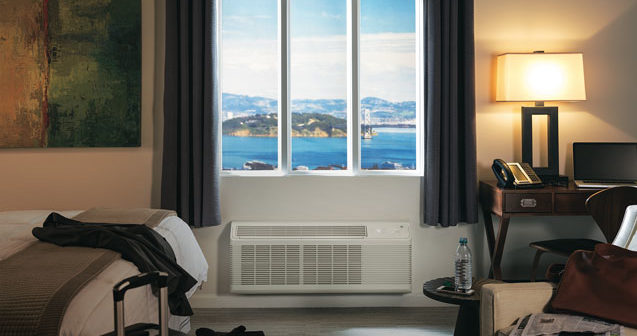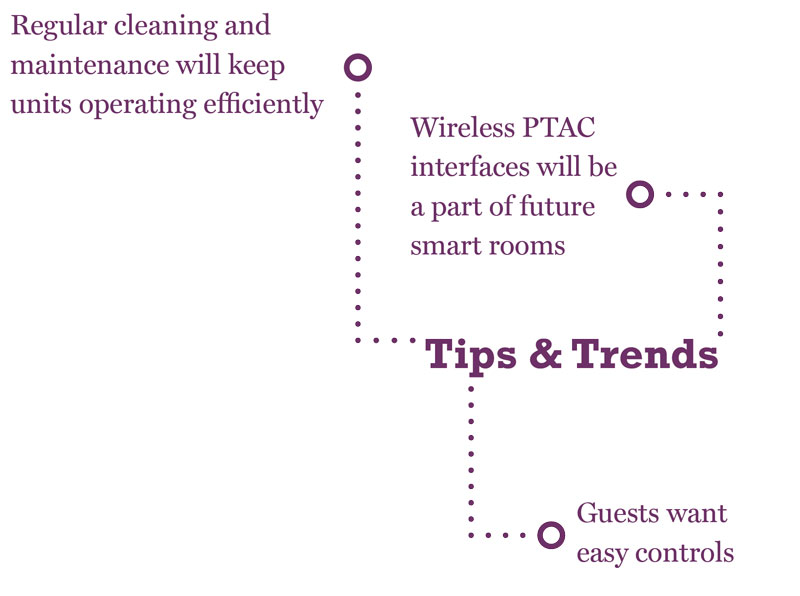 For most guests, the key to a good hotel stay is comfort. A guestroom that is just the right temperature—without too much noise—is what guests expect.
For most guests, the key to a good hotel stay is comfort. A guestroom that is just the right temperature—without too much noise—is what guests expect.
“Guests staying at any hotel expect to have a relaxing and enjoyable experience,” said Douglas Mackemer, national director of parts, supplies and specialized equipment at Carrier Enterprise. “This includes finding a guestroom environment that offers a comfortable temperature setting, yet that does so while keeping operational noise to an absolute minimum.”
Steven Pettus, director of marketing with Amana brand PTAC, agreed. “The majority of guests expect the PTAC unit to properly heat and cool the room while providing acceptable noise levels for sleeping,” he said. “Much like the entire world of HVAC, the guest does not want to have to deal much with the PTAC unit. They expect it to perform flawlessly and consistently throughout their stay. Simply stated, if the room is not adequately heated or cooled—as determined by the hotel guest—the entire experience of lodging could be ruined for the guest. Room comfort is a primary concern for guests, owners and operators.”
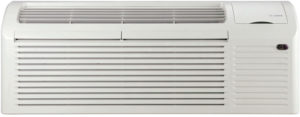
The E-TAC II from Carrier Enterprise provides guests with a quiet stay while providing pre-programmed set-point limits and low energy consumption rates. The products are remote-controlled and wireless-compatible.
Quiet is key for Brigitte Mader-Urschel, commercial director, air conditioning, GE Appliances. “Guests should expect a quiet unit, with a smooth operating sound, which has no rattles or noises that would cause a guest to wake up, and they block outdoor noise from entering the room,” she said.
For the hotels themselves, guest comfort is paramount. “As with any amenity or service, hoteliers first seek out the ability to ensure that their guests are fully satisfied,” said Mackemer. “Regarding PTACs, this involves supplying units that are user-friendly and able to quickly adjust room temperature to individual preferences. With air conditioning units traditionally responsible for increases in energy costs, hoteliers are also mindful for any PTAC solution that while first catering to guest needs, is also able to significantly minimize energy consumption.”
Energy efficiency is one of the top trends for PTACs. “Hotel and motel owners desire energy-efficient performance from PTAC units when they are operational, along with the ability to conserve energy when the room is vacant,” said Pettus. “Heating and cooling guestrooms can be expensive if the PTAC is not an energy-efficient product. Hotel owners and operators who are seeking to lower the operational costs of their rooms should always look to choosing a higher-efficiency PTAC unit.”
Jerad Adams, director of commercial product management for Friedrich, said that energy conservation when rooms are unoccupied is important. “Better occupancy detection reduced the dependency on motion-based sensors, which can fail at night (with little/no movement),” Adams said. “This improved technology increases guest comfort and maximizes the energy-saving capabilities of the system. The better the energy management system (EMS) is with unoccupied management, the better the overall energy savings.”
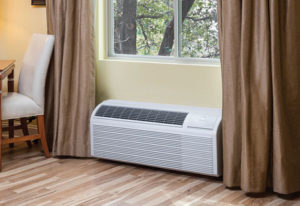
The variable-speed operation of the Friedrich Freshaire PTAC allows the unit to work at the optimal speed to match the true load of the room, according to the company.
He continued, “Great EMS takes into account all room factors, full lighting controls, heating and cooling controls, as well as ventilation control capabilities. Curtailing these electrical requirements greatly reduces the energy consumption in unoccupied rooms, providing considerable utility savings and prolonging the life of the equipment in the room.”
Owners should be paying more attention to energy efficiency, according to Mader-Urschel. “Energy efficiency is a relevant topic for hotel owners; however, we see this usually only come up when owners are looking for a strategic purchase versus making a quick purchase to select a replacement unit,” she said. “It is a topic often not appreciated, which can have impact to an owner’s profitability.”
A key to keeping the units at peak energy efficiency is through regular cleaning and maintenance. “Maintenance of PTAC units is extremely important to protect a hotelier’s investment,” said Mackemer. “Regular maintenance not only affects equipment longevity, but also can improve a unit’s energy consumption and air quality in the room.”
“It is extremely important,” said Ashton Grudnowski, president/owner of Fibercare, a company that provides cleaning services. “Not only for guest-rating levels, but also their bottom line. Savings on replacement costs and energy bills equals cleaning paying for itself—and then some—over the course of the year.”
Pettus agreed. “It is very important to schedule maintenance, servicing and cleaning on a regular basis for PTAC products; lack of any of these three items will likely result in an unpleasant experience for the guest and the hotel owner or operator,” he said. “Many aspects of hotel operations include regular maintenance and cleaning. Imagine a registration area that is cleaned or maintained once a year or only when it isn’t functional. That situation would never be allowed to occur or be considered acceptable practice. The PTAC systems should receive the same consideration.”
The issue of how best to improve indoor air quality (IAQ) is now in the spotlight for lodging and hotel properties both large and small, according to Adams. “IAQ plays a big role in delivering exceptional guest comfort. Until now, there weren’t a lot of options for hoteliers to improve indoor air quality on a room-by-room basis beyond installing big, expensive and complex HVAC systems,” he said. “While older in-room units were designed to effectively heat and cool the room air, typical room air conditioners didn’t address factors like rigorous standards for fresh air intake, filtration and sophisticated humidity control.”
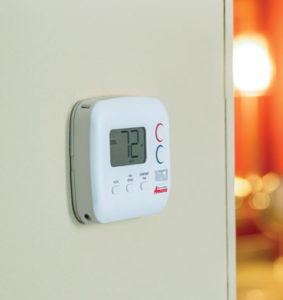
Amana brand PTAC products with the DigiSmart system can reduce energy costs up to 35% compared to its products without it, according to the company.
As hotel brands are moving toward smart rooms, wireless interfaces on PTAC systems will help enhance the guest experience. “As an example, Hilton recently announced a Connected Room platform, a mobile-centric hotel room initiative that is launching this year,” said Adams. “Connected Room allows hotel guests to not only check into their room through their mobile device, but also to use their device to act as their mobile key and provide an interface with all in-room technology, including the HVAC system, which we are thrilled to support. Friedrich is actively working to ensure our equipment and our thermostats are fully ready for the ‘connected room’ experience as this wave of technology quickly adapts.”
When it comes time to purchase a new PTAC system, there are certain things hotels need to take into account. “The hotelier needs to go far beyond evaluating whether a PTAC system will heat and cool effectively and how much it costs,” he said. “Owners need to ask: How efficient is it to operate? Will it improve indoor air quality? Will it address indoor-air-quality issues, such as humidity? Is it simple to install and maintain? Can it precisely adjust to the needs of individual guests to deliver better comfort? Is it quiet and easy to operate? Does the manufacturer stand behind the products? How easy is it to get customer service support?”
“The stability of the PTAC manufacturer is important to hotel owners and operators,” said Pettus. “Where the units are manufactured could be of importance, too. Access to parts and technology upgrades should be considered when selecting a PTAC supplier. Often, the hotel owner or operator should consider the lifetime costs of the PTAC and not just the initial price.”

